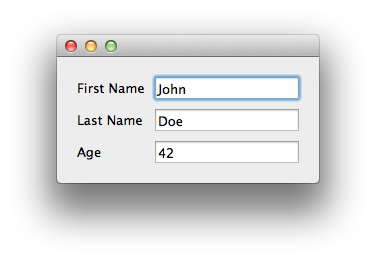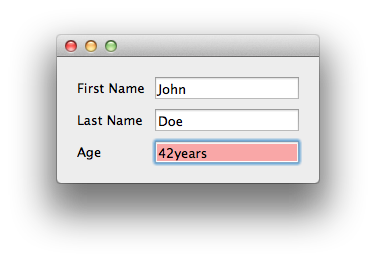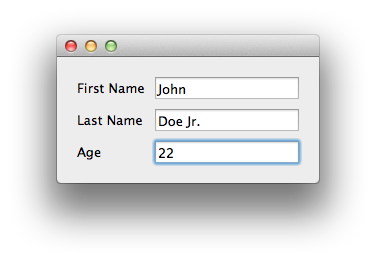Page Contents
This Page
Quick search
Enter search terms or a module, class or function name.
This tutorial expands on the “Hello World” Tutorial to introduce the concepts of reusable component declarations and components from the standard widget library in Enaml. It sets up a GUI with the name and age of a person.
Here is the Enaml file (download here):
#------------------------------------------------------------------------------
# Copyright (c) 2011, Enthought, Inc.
# All rights reserved.
#------------------------------------------------------------------------------
from enaml.widgets.api import Window, Label, Field, Form
from enaml.stdlib.fields import IntField
enamldef PersonForm(Form):
attr person
Label:
text = 'First Name'
Field:
text := person.first_name
Label:
text = 'Last Name'
Field:
text := person.last_name
Label:
text = 'Age'
IntField:
minimum = 0
value := person.age
enamldef PersonView(Window):
attr person
PersonForm:
person := parent.person
Here is the Python code (download here):
#------------------------------------------------------------------------------
# Copyright (c) 2011, Enthought, Inc.
# All rights reserved.
#------------------------------------------------------------------------------
from traits.api import HasTraits, Str, Range, Bool, on_trait_change
import enaml
from enaml.stdlib.sessions import simple_session
from enaml.qt.qt_application import QtApplication
class Person(HasTraits):
""" A simple class representing a person object.
"""
last_name = Str
first_name = Str
age = Range(low=0)
debug = Bool(False)
@on_trait_change('age')
def debug_print(self):
""" Prints out a debug message whenever the person's age changes.
"""
if self.debug:
templ = "{first} {last} is {age} years old."
s = templ.format(
first=self.first_name, last=self.last_name, age=self.age,
)
print s
if __name__ == '__main__':
with enaml.imports():
from person_view import PersonView
john = Person(first_name='John', last_name='Doe', age=42)
john.debug = True
session = simple_session(
'john', 'A view of the Person john', PersonView, person=john
)
app = QtApplication([session])
app.start_session('john')
app.start()
The resulting GUI looks like this (on Mac OSX):

This .enaml file begins like the “Hello World” example with comments, but next we see that we can import other .enaml files in Enaml, just like we can import .py files.:
from enaml.stdlib.fields import IntField
In this case, we are importing the integer field widget IntField from Enaml‘s standard widget library. This widget lets us assign an integer to the value attribute of the widget. The widget automatically converts to and from the text representation of the integer complete with validation and error checking.
Note that this import points to a widget definition in an .enaml file. The import statement looks like Python but imports from an .enaml file.
Next, there is a component definition block. We define a component, in this case an entry form, using a component hierarchy definition. With this block of code, we define a reusable component derived from other components.
enamldef PersonForm(Form):
attr person
Label:
text = 'First Name'
Field:
text := person.first_name
Label:
text = 'Last Name'
Field:
text := person.last_name
Label:
text = 'Age'
IntField:
minimum = 0
value := person.age
A component definition block header line begins with enamldef followed by the name of the component followed by the base component or widget from which it inherits. A widget defined with enamldef must inherit from a builtin widget or another enamldef. The header line ends with a colon:
enamldef PersonForm(Form):
Indented under the header line are statements declaring either attributes or children. attr person declares a person attribute of PersonForm. Because no default value is specified, this attribute must be supplied by code which uses the PersonForm.
Next, we add a series of labels and fields. Form, Label and Field are all from the library of Enaml built-in widgets.
Form is a built-in container that arranges alternating child components into two columns. This is typically done in the way seen here with alternating Label and widget children, though there are no restrictions on the types of widgets which can be used. In a form with an odd number of components, the last component spans both columns.
Label is a built-in component for displaying read-only text.
Field is a built-in widget for entering a text value. Field is used as the base component for many other components that do type conversions.
In the Field code block, we notice a new operator :=. This is the delegation operator, one of the five special operators in the Enaml grammar. It sets up a two-way synchronization between the objects on the left-hand and right-hand sides. That is, changes to the value of the text field in the GUI widget are applied to the value of person.first_name, and changes to the value of person.first_name are displayed in the GUI component.
The IntField component is derived from Field and provides string-to-integer conversion, validation, and error reporting functions. By using the IntField component, we add validation to the GUI, as shown in the example below, where a non-integer value was entered in the age field:

Now, with another enamldef block, we can make a view available using our previously declared PersonForm. If we wanted to, we could add PersonForm many times over in this view or any other view, but for now we’ll keep it simple. Note that we will pass a person object to the view when we create an instance of it.
enamldef PersonView(Window):
attr person
PersonForm:
person = parent.person
Now, on to the Python code.
Enaml is designed to be model framework independent and ships with a formal API for attaching to any Python model framework which provides notification of state change. However, Enaml itself is built with Traits and will work with Traits objects out of the box. The important thing to note is that the Person attribute names match the attribute names of the person object used by the PersonForm in the .enaml file.
class Person(HasTraits):
""" A simple class representing a person object.
"""
last_name = Str
first_name = Str
age = Range(low=0)
debug = Bool(False)
@on_trait_change('age')
def debug_print(self):
""" Prints out a debug message whenever the person's age changes.
"""
if self.debug:
templ = "{first} {last} is {age} years old."
s = templ.format(
first=self.first_name, last=self.last_name, age=self.age,
)
print s
Note that our Person class is designed to print out the name and age of the person when the age attribute changes. See the Traits user guide for help on Traits.
In the code block for launching the script from the command line, we create a Person object and create an application which serves it using the PersonView for the GUI:
if __name__ == '__main__':
import enaml
with enaml.imports():
from person_view import PersonView
john = Person(first_name='John', last_name='Doe', age=42)
john.debug = True
In the previous example, we have seen the simplest way of creating and rendering a view by using the show_simple_view function. In this example, we will go slightly lower level in Enaml by creating a session factory object and the Enaml application directly:
from enaml.stdlib.sessions import simple_session
session = simple_session(
'john', 'A view of the Person john', PersonView, person=john
)
The first two arguments are a name and brief description of the session. The third is the view that we want to use to create this session, in this case PersonView. Everything beyond this is optional, but we want to hook john as the Person instance used by the PersonView.
For writing traditional single-process GUI applications, this pattern will satisfy the majority of use-cases.
Finally, we need to start the application and pass it a list of session factories, start a session named 'john' and run the application:
app = QtApplication([session])
app.start_session('john')
app.start()
Running it from the command line, we see:
$ python person.py

We can then make a change in the GUI and see:
John Doe Jr. is 22 years old.
